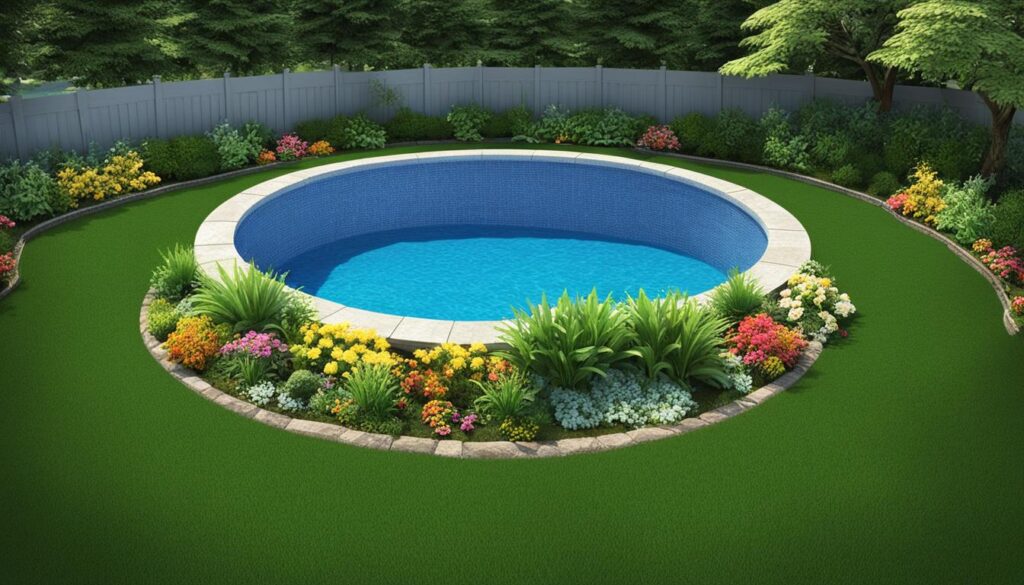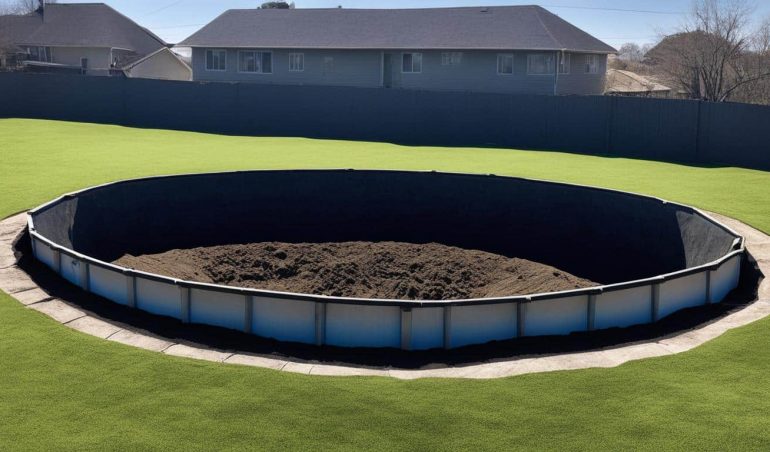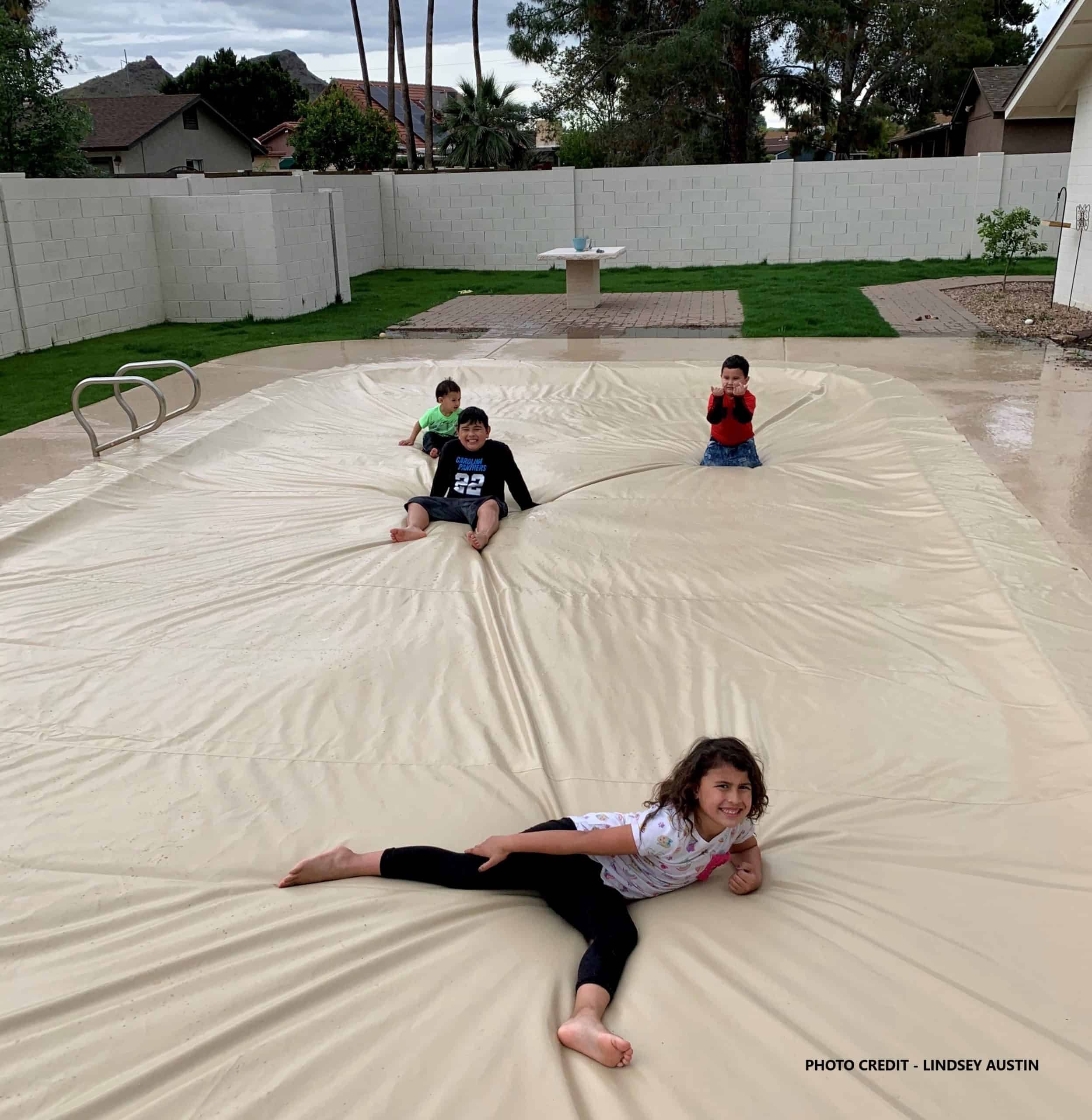Burying an above ground pool can be a practical and aesthetically pleasing option for homeowners looking to enhance their backyard space. Whether you have a sloping or rocky yard or simply want the look of an inground pool without the higher price tag, burying an above ground pool can offer a solution. While not all above ground pools can be buried, there are options available, such as semi-inground pools. These pools are specifically designed to be partially installed above ground and partially in the ground, making them strong and durable enough for burial.
By burying an above ground pool, you can enjoy the benefits of cost savings compared to installing an inground pool. The semi-inground pool provides the look and aesthetics of an inground pool at a lower price point. However, there are considerations to keep in mind when deciding to bury an above ground pool, such as the depth and customizability of the pool, as well as the climate and soil conditions in your area.
Key Takeaways:
- Burying an above ground pool can be a practical and cost-effective alternative to an inground pool.
- Choose a semi-inground pool specifically designed for burial to ensure safety and durability.
- Consider the depth and customizability of the pool, as well as the climate and soil conditions.
- Burying an above ground pool can provide the look and aesthetics of an inground pool at a lower price point.
- Consult with a local pool expert to assess the feasibility of burying an above ground pool in your area.
Types of Above Ground Pools
When it comes to above ground pools, there are three main types to consider: traditional above ground pools, semi-inground pools, and salt-friendly above ground pools.
Traditional above ground pools are the most common type and are not designed to be buried. These pools typically have thinner walls that may not withstand the pressure of the ground. While they are a popular and budget-friendly choice for many homeowners, burying them is not recommended.
Semi-inground pools are specifically designed to be buried partially or completely in the ground. They have thicker walls that ensure the pool can withstand the pressure of the surrounding soil. These pools are built with durable materials resistant to corrosion, making them a suitable option for burying. Semi-inground pools provide the aesthetic appeal of an inground pool without the high cost.
Salt-friendly above ground pools can be either traditional or semi-inground, but they are designed to handle the corrosive effects of saltwater. Saltwater pools require special materials and systems to ensure their longevity in saltwater environments. If you prefer a saltwater pool and have plans to bury it, make sure to choose a pool specifically designed to handle saltwater conditions.
When considering burying an above ground pool, it is essential to choose a semi-inground pool specifically designed for burial. These pools offer the necessary structural integrity and durability to withstand being partially or fully buried in the ground.
Pros and Cons of Burying an Above Ground Pool

Burying an above ground pool offers several advantages. One of the main benefits is the cost savings it provides. By burying a semi-inground pool, homeowners can achieve the look and feel of an inground pool at a lower price point compared to the cost of installing an inground pool. This makes it a more budget-friendly option for those who desire the aesthetics of an inground pool but have budget constraints.
In addition to cost savings, burying an above ground pool also presents the advantage of versatility in terms of depth. Burying allows for customization, enabling homeowners to determine the desired height off the ground. This flexibility in depth makes it possible to create a pool that meets personal preferences and specific needs. Whether it’s a shallower pool for children or a deeper pool for diving, burying an above ground pool provides the opportunity to tailor the pool’s depth to individual requirements.
Quick installation is another advantage of burying an above ground pool. Compared to the time-consuming process of installing an inground pool, the burial of a semi-inground pool can typically be completed within a few days to a week. This expedited installation process allows homeowners to enjoy their pool sooner and spend less time waiting for construction to be completed.
Durability is a key factor to consider when evaluating the advantages of burying an above ground pool. Semi-inground pools, which are designed specifically for burial, have thicker walls and are constructed with durable materials that resist corrosion. This enhanced durability ensures that the buried pool can withstand the pressures associated with being partially or fully underground, providing homeowners with a long-lasting and reliable pool structure.
However, there are also some disadvantages to consider when it comes to burying an above ground pool. One of the drawbacks is the potential for increased cost compared to traditional above ground pools. Stronger materials, such as thicker walls and sturdier components, may be required for buried pools, leading to higher expenses. Additionally, excavation costs may be involved in preparing the area for burial, further contributing to the overall cost.
The disadvantages continue…
Furthermore, customization options may be more limited compared to inground pools. While burying an above ground pool allows for some degree of customization in terms of depth, other design elements may be restricted. Inground pools offer greater flexibility when it comes to design, shape, and additional features, which may not be as readily available for buried above ground pools.
In addition, there may be less flexibility in adjusting the pool’s depth once it is buried. Unlike above ground pools, which can be easily raised or lowered, adjusting the depth of a buried pool may require extensive renovations or alterations to the surrounding area. This limitation should be taken into consideration when determining the desired depth of the pool.
It is important to weigh these pros and cons carefully when making a decision about burying an above ground pool. Considering factors such as cost, customization options, and flexibility can help homeowners determine if burying an above ground pool aligns with their preferences, needs, and budget.
Considerations When Burying an Above Ground Pool
Before burying an above ground pool, there are a few important considerations to keep in mind. One of the key factors is the durability of the pool. Not all above ground pools are designed to be buried, so it’s crucial to choose a pool that is specifically built for burial. This ensures that the pool will hold up during installation, filling, draining, and maintenance.
When burying an above ground pool, it’s also essential to consider the climate and soil conditions. Different regions have varying soil compositions, and it’s important to determine if the soil is suitable for burying a pool. Factors such as moisture content, stability, and compaction of the soil can impact the pool’s longevity and structural integrity. Consulting with a local pool expert can provide valuable insights into the feasibility of burying an above ground pool in your specific area.
Ensuring the durability of the pool and evaluating the climate and soil conditions are crucial steps in the process of burying an above ground pool. By considering these factors, homeowners can make informed decisions and ensure that their buried above ground pool will last for years to come.
Burying an Above Ground Pool vs. Installing an In-Ground Pool
When faced with the decision of whether to bury an above ground pool or install an in-ground pool, several factors come into play. Burying an above ground pool can provide cost savings compared to the higher expenses associated with installing an in-ground pool. The materials and labor required for burying an above ground pool are generally less expensive, making it an attractive option for those on a budget. Moreover, burying an above ground pool offers the aesthetic appeal and look of an in-ground pool without the additional cost.
However, it’s important to consider the limitations that come with burying an above ground pool. One of the main constraints is the depth and customizability of the pool. In-ground pools allow for more flexibility in terms of design and customization options, as they can be tailored to fit individual preferences and needs. In contrast, burying an above ground pool may have restrictions in terms of depth and the ability to customize the pool layout.
Ultimately, the decision between burying an above ground pool and installing an in-ground pool depends on various factors such as personal preferences, needs, and budget. Those seeking a more cost-effective option with a similar aesthetic appeal to an in-ground pool may find burying an above ground pool to be the ideal solution. On the other hand, individuals who prioritize extensive customization and design possibilities may lean towards an in-ground pool. It’s essential to carefully assess these factors to make an informed decision that best suits your specific requirements and budget.
To summarize, burying an above ground pool can provide cost savings and a comparable look to an in-ground pool at a lower price point. However, it’s important to acknowledge the limitations in terms of customizability and depth. Ultimately, the choice between burying an above ground pool and installing an in-ground pool hinges on personal preferences, needs, and available resources.
Conclusion
Burying an above ground pool can offer homeowners numerous benefits and reasons to consider this option for their backyard space. One of the primary advantages is the potential for cost savings. By opting to bury an above ground pool, homeowners can achieve the look and functionality of an in-ground pool at a more affordable price point.
Another key benefit is the versatility in depth that buried pools provide. Homeowners can customize the pool’s height off the ground to fit their preferences and create a seamless integration with their surroundings.
Quick installation is also a notable advantage of burying an above ground pool. Compared to the more time-consuming process of installing an in-ground pool, burying an above ground pool typically requires less time and labor.
Furthermore, the increased durability of buried pools should not be overlooked. Semi-inground pools designed for burial have thicker walls and are constructed with materials that resist corrosion, ensuring longevity and structural integrity.
To make an informed decision about burying an above ground pool, homeowners must carefully consider the limitations and factors involved. It is essential to choose a pool specifically designed for burial and take into account the climate and soil conditions in their area. By weighing the pros and cons, homeowners can determine if burying an above ground pool aligns with their needs, preferences, and budget.
If you want an alternative to burying an above ground pool check with our pool cover experts at Solar Safe Pool Covers for some more ideas we would be happy to help you.
FAQ
Can you bury an above ground pool?
Yes, it is possible to bury an above ground pool. However, not all above ground pools can be buried. Semi-inground pools are specifically designed to be partially buried and are a suitable option for those looking to bury their pool.
What are the types of above ground pools?
There are three main types of above ground pools: traditional above ground pools, semi-inground pools, and salt-friendly above ground pools.
What are the pros and cons of burying an above ground pool?
Burying an above ground pool offers advantages such as cost savings, versatility in depth, quick installation, and increased durability. However, there are also disadvantages to consider, including higher expenses and limited customization options.
What considerations should be kept in mind when burying an above ground pool?
It is important to choose a pool specifically designed for burial and to consider the durability of the pool. Additionally, the climate and soil conditions in your area should be assessed to ensure the feasibility of burying an above ground pool.
How does burying an above ground pool compare to installing an in-ground pool?
Burying an above ground pool can offer cost savings and similar aesthetics to an in-ground pool. However, there may be limitations in terms of depth and customization compared to in-ground pools.
What are the reasons to bury an above ground pool?
Burying an above ground pool can enhance the aesthetics of your backyard and create more space. It can also provide the look of an in-ground pool at a lower price point.






